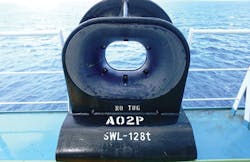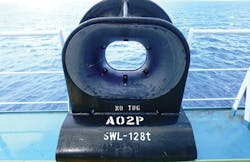Chock Liner mooring technology designed to enhance safety, performance
Nylacast has introduced the Chock Liner, a mooring system that is designed to support safe and reliable moorings of all types and purpose through its patented low friction technology.
The transition from steel wire rope to fiber rope is widespread across industry. Fiber rope has a good strength to weight ratio and ease of handling, resulting in much lower risk of injury.
Although advantageous, a major weakness of fiber rope is poor resistance to external abuse and abrasion through everyday operations and poor surface contact. Abrasion continues to be one of the most common root causes of rope failure and reduction in its residual strength.
It is impossible for synthetic rope to perform to its maximum capabilities when used with poorly maintained deck equipment, often rusted or with a rough surface finish. Rope manufacturers recommend surfaces are correctly prepared, maintained and routinely inspected before and after rope installation. A 300-microinch (7.62-microns) finish is recommended for all deck hardware which comes into contact with the rope, in addition to the avoidance of chocks heavily scored from previous wire rope use.
The Nylacast Chock Liner is said to provide vessels with the ability to be moored with greater safety, performance, and efficiency.
The Chock Liner mooring technology is said to provide vessels with the ability to be moored with greater safety, performance and efficiency, offering multiple benefits. The Chock Liner is versatile and capable of being fitted to brand new vessels and retro fitted to existing chocks and panama fairleads with no hot works or dry docking required.
Increased safety is a feature of the Chock Liner which reduces rope wear and abrasion, reducing the risk of breaking or failure. There is also no need for crew members to be near mooring lines under tension, as minimal (if any) chafe protection is required following installation of the new system.
The Chock Liner’s smooth surface and finish and its material characteristics provides better equalization of mooring loads, especially when in high swell. The self-lubricating, low friction Chock Liner material requires little or no maintenance and no painting, coating or external protection. Corrosion resistant materials technology is featured on the new system, providing protection against the arduous environments faced in the global maritime industry.
Custom manufactured from initial chemistry to end product, the Chock Liner is available for use on all chock and vessel sizes. Developed to optimize and enhance vessel moorings, much of the advantages derive from the unique materials technology developed through over 20 years of field experience in design, testing and material selection with fiber ropes.
The featured materials technology in Nylacast Chock Liners allows for the accommodation of HMPE fibre rope with lower risk of abrasion and wear when in contact with the chock or panama fairlead. The Chock Liner is also suitable for polyester/polypropylene, polyester and nylon ropes, as required for FLNG, FSRU and STS where a specific synthetic pennant may pass through the fairlead. In all cases, due care and attention is required in relation to the loads involved, chock designs and rope sizes.
Nylacast says that the new mooring technology has been featured on various vessel types including passenger ships and ferries, container vessels, service vessels, LNG tankers and product carriers, FPSO and special purpose vessels, navy, yachts and fishing vessels. The low weight, low friction materials technology used within the Chock Liner is also featured in a wide range of marine equipment and products from sheaves and pulleys to spooling shells and rollers. •

